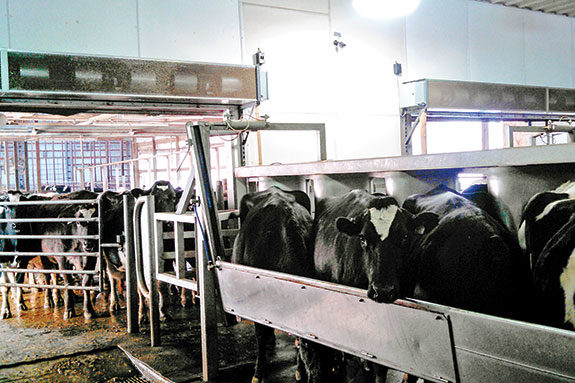Farms may have the most diverse list of air curtain (or air door) uses than perhaps any other application. First used decades ago in industrial buildings for indoor-outdoor environmental separation at open doorways, air curtains on farms today are used for energy conservation, flying insect prevention, employee and livestock air comfort, productivity increases, supplemental heating and cooling, ventilation and other uses.
Perhaps more than energy savings, using air curtains as a chemical-free deterrence to flying insect infiltration is becoming the number one reason farms are installing air curtains.
Creating a no-flies zone
Flying insects can’t navigate through air curtain discharge air velocities that generally range from 1,000 to 3,000 feet per minute.
An air curtain essentially allows livestock free access through open doorways but rejects flying insects, which can impact animal comfort, health and sanitation.
Sanitation is of the utmost consideration, especially when considering National Sanitation Foundation (NSF) and local county and state health codes.
In a research study, R.D. Moon reports “horn flies and stable flies cost Minnesota dairy and beef producers approximately $40 million (in 2005 dollars) per year in lost products and $10 million for control and disease treatments during a two-year period.”
With those significant losses, an air curtain on a livestock building represents a relatively minor investment with a short payback.
Stable flies are especially problematic for dairy farms because of the painful bites they inflict on the lower legs of cows, especially those being milked. Many times this prompts cows to inadvertently kick milking parlor workers and prematurely dislodge the automatic milking equipment.
Air curtains are a proven technology according to a research project sponsored by USDA-ARS at the Center for Medical Agricultural and Veterinarian Entomology (CMAVE), Gainesville, Florida.
Disease-carrying mosquitoes and flies transported on international flights can be problematic for air travel and potential candidates for introducing non-indigenous diseases into the U.S.
In an attempt to find an alternative to pesticide use in airplanes to eliminate mosquitoes and flies, CMAVE tested a vertically mounted air curtain’s effectiveness on a simulated airline fuselage in a test lab with a controlled release of 50 house flies and three species of 150 mosquitoes.
The test simulated 25 passes of passengers through the air stream, and the air curtains were 99 to 100 percent successful at keeping the insects out of the fuselage, according to Jerry Hogsette, Jr., Ph.D., a research entomologist at the USDA-ARS.
Farms, according to Hogsette, are many times blamed for waves of flying insects that descend on nearby retailers and homes when farmers clean out their livestock-holding buildings.
Using air curtains 24-7 can minimize flying insect populations from entering farm buildings and keep county and state health inspectors satisfied on sanitation issues.
Many farms rely on insect light traps and glue boards, which are only reactionary devices that address the problem after the flying insect has gained access to a building.
Air curtains are more proactive because they reduce flying insect infiltration before they gain entry, according to Dan Clark, a nationally known fly expert and president of FlyTech Supply.
Case in point is one warehouse that was infested with thousands of flies. Insect fecal matter littered interior table and floor surfaces. Forty light traps and an arsenal of electrocute devices were killing flies but were overwhelmed by the steady supply from unobstructed pedestrian doors.
Three air curtains were installed, which reduced fly infiltration to less than .01 percent and cut the customers’ extermination costs from 40 light traps to just four to handle any stragglers.
A hog farm in Arkansas was identified as flying insect chaos with waves of flies throughout the 20,000-square-foot facility. Animal sanitation and comfort were the major concerns of the farm owner.
Once the existing flies were removed, the air curtains deterred future fly infiltration, and the farmer was happy.
While air curtains are ideal flying insect deterrents, their air stream must have the proper velocity, volume and uniformity (VVU) for effective flying insect prevention. Unfortunately, not all manufacturers design a product that lives up to their purported performance specifications.
Preventing milking equipment freeze-ups
Sometimes a farm discovers a new use for air curtains. For example, the 40-acre Griesen’s Family Dairy in Prairie du Sac, Wisconsin, recently discovered air curtains can prevent milking equipment freeze-ups during sub-freezing days.
The air curtains help retain heat in the farm’s double-12 milking parlor when the radiant floor-boiler heating system can’t maintain temperatures. Griesen’s keeps the two 16-foot-wide cow entryways open 24-7 for uninterrupted passage of its 680 cows and high productivity.
Owner Hans Griesen first tried portable salamander forced-air heaters. The entrances were warmer; however, the $100-per-day cost for fuel, kerosene emission odors and potential fire hazard sent him looking elsewhere.
An employee dedicated to opening and closing the two doorways all day was considered cost-prohibitive, even at minimum wage rates, according to Griesen.
Griesen also considered both strip curtains so the entry doors could stay open. Strip curtains were too obstructive to the animals.
Finally, a material-handling dealer and a manufacturer’s representative worked with factory engineers to specify two 16-foot-long, one-piece air curtains. The air curtains are mounted above the milking parlor’s open doorways and retain up to 80 percent of the facility’s energy even during wind loads of up to 5 mph.
Energy conservation
The ability of air curtains to retain heat or air conditioning is becoming more important for farm buildings due to rising energy prices. While few farm buildings are air-conditioned, many are heated for animal as well as employee comfort.
Air curtains can retain as much as 80 percent of the heat loss during an open-door event. Paybacks on an air curtain for energy conservation is typically less than two years and many times less than one year.
Many farms that run on-site meat processing and food storage also find air curtains advantageous in retaining refrigeration. Farms with walk-in coolers can gain great energy savings with air curtain kits specially designed for quick and easy walk-in cooler installations.
While existing walk-in coolers are grandfathered, new units are subject to the new Energy Policy and Conservation Act (EPCA) (Section 312) compliance.
The code mandates air infiltration reduction methods, such as strip curtains, spring-hinged swinging vinyl doors or other options, such as an air curtain, for all walk-in coolers manufactured after Jan. 1, 2009.
EPCA doesn’t specify which is the most efficient; however, air curtains undoubtedly require less maintenance, have longer life cycles and are safer alternatives for employee passage.
Obviously, most farms aren’t going to air-condition livestock buildings; however, in the process of preventing flying insects, the byproduct of air curtain airflow creates ventilation within the facility for animal comfort.
Furthermore, air curtains can be customized for supplemental heating with electric or gas-fired coils, or hot water or steam coils supplied by a farm’s central plant.
There is an almost infinite number of farm uses for air curtains that manufacturers can customize into their product. PD
Michael Farber is a 17-year veteran of the industrial equipment and manufacturing industry and is currently sales manager for the industrial division of air curtain manufacturer Berner International, New Castle, Pennsylvania. Farber grew up on a farm in western Pennsylvania.
PHOTO
Two air curtains are positioned over the entry doors to Hans Griesen’s double-12 herringbone parlor. These prevent heat from escaping during the winter without hindering cattle entry. Photo courtesy of Berner International.
How air curtains work
Air curtain technology draws interior air from the facility and discharges it through field-adjustable (plus or minus 20-degree) linear nozzles that “seal” the doorway with a non-turbulent air stream that meets the floor approximately at the threshold of the door opening.
A properly sized and AMCA-certified air curtain can contain approximately 70 to 80 percent of that air and return it to the space. Because the air curtain discharges air at velocities generally in the range from 1,000 to 3,000 feet per minute, it effectively prevents outside air and flying insect infiltration.
Volume, velocity and uniformity of the air stream are critical factors in an air curtain’s effectiveness. Air curtains are typically activated by a limit switch triggered when the door opens and deactivated when closed.








